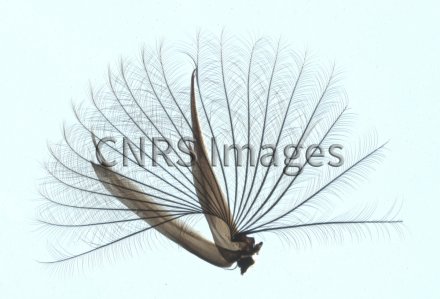Production year
2017

© Abderrahman KHILA / IGFL / CNRS Images
20170118_0006
Feathery fan-like structure with claws, found on the tip of the middle legs of a water strider, rhagovelia. The fan was dissected and mounted between a slide and cover slip with the aid of a transparent viscous solution. It was observed using an optical microscope at a 20X magnification. Water-repellent hairs on the legs of these insects enable to move across water. They are also able to travel upstream along rivers, with the aid of fan-shaped structures on the tips of their second pair of legs, which they use as swimming fins. As these fans exist in rhagovelias alone, they offer a good model for studying the emergence of so-called "new" structures (evolutionary innovations). These water striders have two hitherto unknown genes that must be expressed in order for the legs to develop with an intact fan. One of these genes is of early origin, as it is present in the common ancestor of all heteroptera bugs, whereas the second gene is more recent, existing in rhagovelia alone. The striking similarity between the two genes suggests that a genetic mutation may have given rise to the more recent gene by duplication of the ancestral one.
The use of media visible on the CNRS Images Platform can be granted on request. Any reproduction or representation is forbidden without prior authorization from CNRS Images (except for resources under Creative Commons license).
No modification of an image may be made without the prior consent of CNRS Images.
No use of an image for advertising purposes or distribution to a third party may be made without the prior agreement of CNRS Images.
For more information, please consult our general conditions
2017
Our work is guided by the way scientists question the world around them and we translate their research into images to help people to understand the world better and to awaken their curiosity and wonderment.